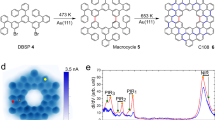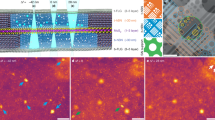Abstract
Evaluating the built-in functionality of nanomaterials under practical conditions is central for their proposed integration as active components in next-generation electronics. Low-dimensional materials from single atoms to molecules have been consistently resolved and manipulated under ultrahigh vacuum at low temperatures. At room temperature, atomic-scale imaging has also been performed by probing materials at the solid/liquid interface. We exploit this electrical interface to develop a robust electronic decoupling platform that provides precise information on molecular energy levels recorded using in situ scanning tunnelling microscopy/spectroscopy with high spatial and energy resolution in a high-density liquid environment. Our experimental findings, supported by ab initio electronic structure calculations and atomic-scale molecular dynamics simulations, reveal direct mapping of single-molecule structure and resonance states at the solid/liquid interface. We further extend this approach to resolve the electronic structure of graphene monolayers at atomic length scales under standard room-temperature operating conditions.
This is a preview of subscription content, access via your institution
Access options
Subscribe to this journal
Receive 12 print issues and online access
$259.00 per year
only $21.58 per issue
Buy this article
- Purchase on Springer Link
- Instant access to full article PDF
Prices may be subject to local taxes which are calculated during checkout




Similar content being viewed by others
References
De Oteyza, D. G. et al. Direct imaging of covalent bond structure in single-molecule chemical reactions. Science 340, 1434–1437 (2013).
Gross, L., Mohn, F., Moll, N., Liljeroth, P. & Meyer, G. The chemical structure of a molecule resolved by atomic force microscopy. Science 325, 1110–1114 (2009).
Repp, J., Meyer, G., Stojkovic, S. M., Gourdon, A. & Joachim, C. Molecules on insulating films: Scanning-tunneling microscopy imaging of individual molecular orbitals. Phys. Rev. Lett. 94, 026803 (2005).
Shin, H. J. et al. State-selective dissociation of a single water molecule on an ultrathin MgO film. Nature Mater. 9, 442–447 (2010).
Rabe, J. P. Molecules at interfaces: STM in materials and life sciences. Ultramicroscopy 42–44, 41–54 (1992).
Uji, I. H. et al. Scanning tunneling microscopy and spectroscopy of donor–acceptor–donor triads at the liquid/solid interface. ChemPhysChem 6, 2389–2395 (2005).
De Feyter, S. & De Schryver, F. C. Self-assembly at the liquid/solid interface: STM reveals. J. Phys. Chem. 109, 4290–4302 (2005).
Hulsken, B. et al. Real-time single-molecule imaging of oxidation catalysis at a liquid–solid interface. Nature Nanotech. 2, 285–289 (2007).
Sonnenfeld, R. & Hansma, P. K. Atomic-resolution microscopy in water. Science 232, 211–213 (1986).
Itaya, K., Sugawara, S. & Higaki, K. In situ scanning tunneling microscopy for platinum surfaces in aqueous solutions. J. Phys. Chem. 92, 6714–6718 (1988).
Giambattista, B. et al. Atomic resolution images of solid–liquid interfaces. Proc. Natl Acad. Sci. USA 84, 4671–4674 (1987).
De Feyter, S., Xu, H. & Mali, K. Dynamics in self-assembled organic monolayers at the liquid/solid interface revealed by scanning tunneling microscopy. Chimia 66, 38–43 (2012).
Katsonis, N., Marchenko, A. & Fichou, D. Dynamics and spectroscopy of single C60 molecules adsorbed on Au(111) at the liquid–solid interface. J. Photochem. Photobiol. A 158, 101–104 (2003).
Rabe, J. P. & Buchholz, S. Direct observation of molecular structure and dynamics at the interface between a solid wall and an organic solution by scanning tunneling microscopy. Phys. Rev. Lett. 66, 2096–2099 (1991).
Den Boer, D. et al. Detection of different oxidation states of individual manganese porphyrins during their reaction with oxygen at a solid/liquid interface. Nature Chem. 5, 621–627 (2013).
Ciesielski, A., Palma, C. A., Bonini, M. & Samori, P. Towards supramolecular engineering of functional nanomaterials: Pre-programming multi-component 2D self-assembly at solid–liquid interfaces. Adv. Mater. 22, 3506–3520 (2010).
Elemans, J. A. A. W. & De Feyter, S. Structure and function revealed with submolecular resolution at the liquid-solid interface. Soft Matter 5, 721–735 (2009).
Samori, P. et al. Supramolecular staircase via self-assembly of disklike molecules at the solid–liquid interface. J. Am. Chem. Soc. 123, 11462–11467 (2001).
Jackel, F., Watson, M. D., Mullen, K. & Rabe, J. P. Prototypical single-molecule chemical-field-effect transistor with nanometer-sized gates. Phys. Rev. Lett. 92, 188303 (2004).
Albrecht, T. et al. Scanning tunneling spectroscopy in an ionic liquid. J. Am. Chem. Soc. 128, 6574–6575 (2006).
Moth-Poulsen, K. & Bjornholm, T. Molecular electronics with single molecules in solid-state devices. Nature Nanotech. 4, 551–556 (2009).
Gopakumar, T. G. et al. Coverage-driven electronic decoupling of Fe-phthalocyanine from a Ag(111) substrate. J. Phys. Chem. C 115, 12173–12179 (2011).
Gross, L. Recent advances in submolecular resolution with scanning probe microscopy. Nature Chem. 3, 273–278 (2011).
Nirmalraj, P. N., Schmid, H., Gotsmann, B. & Riel, H. Nanoscale origin of defects at metal/molecule engineered interfaces. Langmuir 29, 1340–1345 (2013).
Zhang, H-M., Xie, Z-X., Mao, B-W. & Xu, X. Self-assembly of normal alkanes on the Au (111) surfaces. Chem. Eur. J. 10, 1415–1422 (2004).
Marchenko, O. & Cousty, J. Molecule length-induced reentrant self-organization of alkanes in monolayers adsorbed on Au(111). Phys. Rev. Lett. 84, 5363–5366 (2000).
Nerngchamnong, N. et al. The role of van der Waals forces in the performance of molecular diodes. Nature Nanotech. 8, 113–118 (2013).
Akari, S. et al. Anomalous voltage dependence of tunnelling microscopy in WSe2 . J. Microsc. 152, 521–526 (1988).
Marchenko, A. & Cousty, J. C60 self-organization at the interface between a liquid C60 solution and a Au(111) surface. Surf. Sci. 513, 233–237 (2002).
Weckesser, J., Barth, J. V. & Kern, K. Mobility and bonding transition of C60 on Pd(110). Phys. Rev. B 64, 161403 (2001).
Heinz, H., Vaia, R. A., Farmer, B. L. & Naik, R. R. Accurate simulation of surfaces and interfaces of face-centered cubic metals using 12-6 and 9-6 Lennard-Jones potentials. J. Phys. Chem. 112, 17281–17290 (2008).
Grill, L. Functionalized molecules studied by STM: Motion, switching and reactivity. J. Phys. Condens. Matter 20, 053001 (2008).
Neel, N. et al. Controlled contact to a C60 molecule. Phys. Rev. Lett. 98, 065502 (2007).
Griessl, S. J. H. et al. Room-temperature scanning tunneling microscopy manipulation of single C60 molecules at the liquid–solid interface: Playing nanosoccer. J. Phys. Chem. B 108, 11556–11560 (2004).
Lu, J. et al. Using the graphene Moiré pattern for the trapping of C60 and homoepitaxy of graphene. ACS Nano 6, 944–950 (2011).
Nikolai Severin, J. B., Alexey, A. K. & Jurgen, P. R. Manipulation and overstretching of genes on solid substrates. Nano Lett. 4, 577–579 (2004).
Wang, Y., Kroger, J., Berndt, R. & Tang, H. Molecular nanocrystals on ultrathin NaCl films on Au(111). J. Am. Chem. Soc. 132, 12546–12547 (2010).
Franke, K. J. et al. Reducing the molecule–substrate coupling in C60-based nanostructures by molecular interactions. Phys. Rev. Lett. 100, 036807 (2008).
Bilan, S., Zotti, L. A., Pauly, F. & Cuevas, J. C. Theoretical study of the charge transport through C60-based single-molecule junctions. Phys. Rev. B 85, 205403 (2012).
Néel, N. et al. Controlled contact to a C60 molecule. Phys. Rev. Lett. 98, 065502 (2007).
Franke, K. J. & Pascual, J. I. Effects of electron–vibration coupling in transport through single molecules. J. Phys. Condens. Matter 24, 394002 (2012).
Lu, X., Grobis, M., Khoo, K. H., Louie, S. G. & Crommie, M. F. Charge transfer and screening in individual C60 molecules on metal substrates: A scanning tunneling spectroscopy and theoretical study. Phys. Rev. B 70, 115418 (2004).
Martin, C. A. et al. Fullerene-based anchoring groups for molecular electronics. J. Am. Chem. Soc. 130, 13198–13199 (2008).
Lortscher, E. et al. Bonding and electronic transport properties of fullerene and fullerene derivatives in break-junction geometries. Small 9, 209–214 (2013).
Markussen, T., Settnes, M. & Thygesen, K. S. Robust conductance of dumbbell molecular junctions with fullerene anchoring groups. J. Chem. Phys. 135, 144104–144106 (2011).
Nirmalraj, P. N., Lutz, T., Kumar, S., Duesberg, G. S. & Boland, J. J. Nanoscale mapping of electrical resistivity and connectivity in graphene strips and networks. Nano Lett. 11, 16–22 (2011).
Decker, R. et al. Local electronic properties of graphene on a BN substrate via scanning tunneling microscopy. Nano Lett. 11, 2291–2295 (2011).
Ugeda, M. M. et al. Point defects on graphene on metals. Phys. Rev. Lett. 107, 116803 (2011).
Zheng, J. et al. Interfacial properties of bilayer and trilayer graphene on metal substrates. Sci. Rep. 3, 2081 (2013).
Banhart, F., Kotakoski, J. & Krasheninnikov, A. V. Structural defects in graphene. ACS Nano 5, 26–41 (2010).
Cho, J. et al. Structural and electronic decoupling of C60 from epitaxial graphene on SiC. Nano Lett. 12, 3018–3024 (2012).
Luican, A., Li, G. & Andrei, E. Y. Quantized Landau level spectrum and its density dependence in graphene. Phys. Rev. B 83, 041405 (2011).
Miller, D. L. et al. Observing the quantization of zero mass carriers in graphene. Science 324, 924–927 (2009).
Giovannetti, G. et al. Doping graphene with metal contacts. Phys. Rev. Lett. 101, 026803 (2008).
Schull, G., Frederiksen, T., Brandbyge, M. & Berndt, R. Passing current through touching molecules. Phys. Rev. Lett. 103, 206803 (2009).
Acknowledgements
The authors thank R. Stutz and H. Schmid for metal-deposition experiments, M. Tschudy for liquid-cell fabrication and E. Lörtscher for designing the noise-free laboratories. P.N. thanks H. Wolf, F. Schwarz and J. Boland for useful discussions. This work was supported by the Marie Curie Actions-Intra-European Fellowship (IEF-PHY) under grant agreement No 275074 ‘To Come’ within the 7th European Community Framework Programme. D.T. thanks Science Foundation Ireland (SFI) for financial support under Grant Number 11/SIRG/B2111 and the SFI/Higher Education Authority Irish Center for High-End Computing (ICHEC). This work was supported by the EC FP7ITN ‘FUNMOLS’ Project Number: PITN-GA-2008-212942.
Author information
Authors and Affiliations
Contributions
P.N. designed and performed the in situ STM/STS experiments. M.S. carried out the ellipsometry measurements and data analysis. A.M-O. and N.M. synthesized the functionalized C60 molecules and performed the electrochemical characterization. D.T. designed and performed the molecular dynamics simulations and DFT calculations. All authors contributed and commented on the manuscript and analysis of the data.
Corresponding author
Ethics declarations
Competing interests
The authors declare no competing financial interests.
Supplementary information
Supplementary Information
Supplementary Information (PDF 7720 kb)
Rights and permissions
About this article
Cite this article
Nirmalraj, P., Thompson, D., Molina-Ontoria, A. et al. Nanoelectrical analysis of single molecules and atomic-scale materials at the solid/liquid interface. Nature Mater 13, 947–953 (2014). https://doi.org/10.1038/nmat4060
Received:
Accepted:
Published:
Issue Date:
DOI: https://doi.org/10.1038/nmat4060
This article is cited by
-
Graphene wrinkle effects on molecular resonance states
npj 2D Materials and Applications (2018)
-
Subcellular Imaging of Liquid Silicone Coated-Intestinal Epithelial Cells
Scientific Reports (2018)
-
Templated bilayer self-assembly of fully conjugated π-expanded macrocyclic oligothiophenes complexed with fullerenes
Nature Communications (2017)
-
Fingerprinting Electronic Molecular Complexes in Liquid
Scientific Reports (2016)
-
A robust molecular probe for Ångstrom-scale analytics in liquids
Nature Communications (2016)



